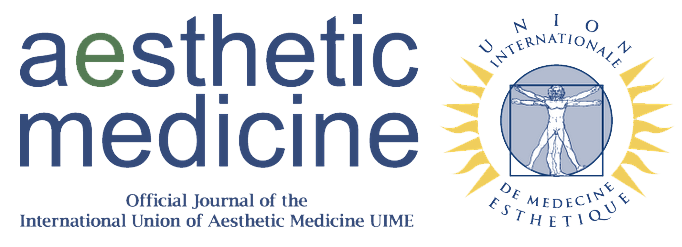Receptor phenomena and signaling pathways in the use of low doses insulin as a bio-restructuring agent in Aesthetic Medicine: promotes biological aging. Meta-analysis and systematic review of the literature
Keywords:
insulin low dose , Grow factors , neocollagenogenesis , fibrosisAbstract
The method of using low-dose insulin is indicated by some authors in aesthetic medicine as a technique for the bio-restructuring of tissues through the dermo-epidermal mesotherapy technique also in the areas of the face, neck and décolleté. The result of this off-label method will be that of an apparent aesthetic improvement, but with the formation of scar tissue and fibrosis in the injection tissue as well as in the surrounding tissues due to the inflammatory stimulus on the target cells and an excess production of Extracellular Matrix (ECM) deposited by fibroblasts with the formation of fibrotic tissue. In this meta-analysis and review of the literature, we delve into the mechanism it produces through which it triggers these effects and the aging process triggered through fibrosis in the tissues. Attention is also paid to any dosages and characteristics of the different types of insulins which can give different results up to the possible phenomena of pharmacological intolerance. This procedure will exclusively result in biological aging of the tissues.
References
Svolacchia F, Svolacchia L. Off-label use of a medium-high molecular weight, isotonic and sterile hyaluronic acid in aesthetic medicine: Cases report. J Transl Sci.2018; 4(6):1-4.
Gueniche A, Castiel-Higounenc I. Efficacy of Glucosamine Sulphate in Skin Ageing: Results from an ex vivo Anti-Ageing Model and a Clinical Trial. Skin Pharmacol Physiol. 2017; 30(1):36-41.
Genovese L, Corbo A, Sibilla S. An Insight into the Changes in Skin Texture and Properties following Dietary Intervention with a Nutricosmeceutical Containing a Blend of Collagen Bioactive Peptides and Antioxidants. Skin Pharmacol Physiol. 2017; 30(3):146-158.
Holzer G, Markov GV, Laudet V. Evolution of Nuclear Receptors and Ligand Signaling: Toward a Soft Key-Lock Model? Curr Top Dev Biol. 2017; 125:1-38.
Heinzelmann K, Lehmann M, Gerckens M, et al. Cell-surface phenotyping identifies CD36 and CD97 as novel markers of fibroblast quiescence in lung fibrosis. Am J Physiol Lung Cell Mol Physiol. 2018; 315(5):L682-L696.
Oryan A, Alemzadeh E. Effects of insulin on wound healing: A review of animal and human evidences. Life Sci. 2017; 174:59-67.
O’ Brien, IR.M. Granner DK. Regulation of gene expression by insulin. Phisiol Rev. 1996; 76(4):1109-1161.
Goodman & Gilman. The pharmacological basis of therapeutics. Tenth edition. 2003; 1467, 1597, 1599, 1600, 1601, 1602, 1612. (Milano – Italy).
Granner DK. The molecular biology of insulin action on protein synthesis. Kidney Int. 1987; 23 (Suppl):s82-s96.
Tazearslan C, Huang J, Barzilai N, Suh Y. Impaired IGF1R signaling in cells expressing longevity-associated human IGF1R alleles. Aging Cell. 2011; 10(3):551-4.
Pontieri GM, Russo MA, Frati L. General pathology and general pathophysiology. Piccin. IV edizione 2015; Volume 1-2, pag. 1249.
Brandt K, Grünler J, Brismar K, Wang J. Effects of IGFBP-1 and IGFBP-2 and their fragments on migration and IGF-induced proliferation of human dermal fibroblasts. Growth Horm IGF Res. 2015; 25(1):34-40.
Virkamaki A, Ueki K, Kahn CR. Protein-protein interaction in insulin signaling and the molecular mechanism of insulin resistance. J Clin Invest. 1999; 103(7):931-943.
Hembree JR, Harmon CS, Nevins TD, Eckert RL Regulation of human dermal papilla cell production of insulin-like growth factor binding protein-3 by retinoic acid, glucocorticoids, and insulin-like growth factor-1. J Cell Physiol. 1996; 167(3):556-61.
Bitar MS, Al-Mulla F. ROS constitute a convergence nexus in the development of IGF1 resistance and impaired wound healing in a rat model of type 2 diabetes. Dis Model Mech. 2012; 5(3):375-88.
Osiecka-Iwan A, Moskalewski S, Hyc A. Influence of IGF1, TGFβ1, bFGF and G-CSF/M-CSF on the mRNA levels of selected matrix proteins, cytokines, metalloproteinase 3 and TIMP1 in rat synovial membrane cells. Folia Histochem Cytobiol. 2016; 54(3):159-165.
Barnes PJ, Celli BR. Systemic manifestations and comorbidities of COPD. Eur Respir J. 2009; 33(5):1165-85.
Sai K, Lal A, Maradana JL, Velamala PR, Nitin T. Hypokalemia associated with mifepristone use in the treatment of Cushing's syndrome. Endocrinol Diabetes Metab Case Rep. 2019; 2019:19-0064.
Fierro-Macías AE, Floriano-Sánchez E, Mena-Burciaga VM, et al. [Association between IGF system and PAPP-A in coronary atherosclerosis]. Arch Cardiol Mex. 2016; 86(2):148-56.
Hiriart-Urdanivia M, Sánchez-Soto C, Velasco M, Sabido-Barrera J, Ortiz-Huidobro RI. El receptor soluble de insulina y el síndrome metabólico. Gac Med Mex. 2019;155(5):541-545.
Polonsky KS, Rubenstein AH. Current approaches to measurement of insulin secretion. Diabetes Metab Rev. 1986; 2(3-4):315-29.
Sciacca L, Cassarino MF, Genua M, et al. Insulin analogues differently activate insulin receptor isoforms and post-receptor signalling. Diabetologia. 2010; 53(8):1743-53.
Binder C, Lauritzen T, Faber O, Pramming S. Insulin pharmacokinetics. Diabetes Care. 1984; 7(2):188-99.
Zhu Y, Chen L, Song B, et al. Insulin-like Growth Factor-2 (IGF-2) in Fibrosis. Biomolecules. 2022; 12(11):1557.
Downloads
Published
Issue
Section
License
Copyright (c) 2024 Fabiano Svolacchia, Lorenzo Svolacchia

This work is licensed under a Creative Commons Attribution-NonCommercial 4.0 International License.
This is an Open Access article distributed under the terms of the Creative Commons Attribution License (https://creativecommons.org/licenses/by-nc/4.0) which permits unrestricted use, distribution, and reproduction in any medium, provided the original work is properly cited.
Transfer of Copyright and Permission to Reproduce Parts of Published Papers.
Authors retain the copyright for their published work. No formal permission will be required to reproduce parts (tables or illustrations) of published papers, provided the source is quoted appropriately and reproduction has no commercial intent. Reproductions with commercial intent will require written permission and payment of royalties.

This work is licensed under a Creative Commons Attribution-NonCommercial 4.0 International License.





